
Question Number 2526 by Filup last updated on 22/Nov/15
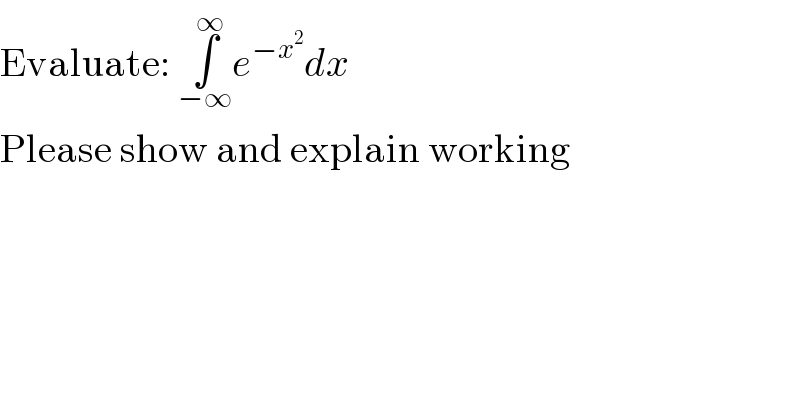
$$\mathrm{Evaluate}:\:\underset{−\infty} {\overset{\infty} {\int}}{e}^{−{x}^{\mathrm{2}} } {dx} \\ $$$$\mathrm{Please}\:\mathrm{show}\:\mathrm{and}\:\mathrm{explain}\:\mathrm{working} \\ $$
Commented by Filup last updated on 22/Nov/15
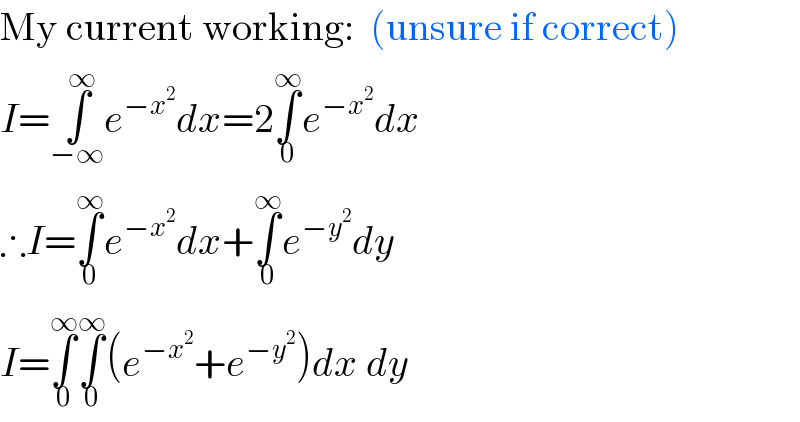
$$\mathrm{My}\:\mathrm{current}\:\mathrm{working}:\:\:\left(\mathrm{unsure}\:\mathrm{if}\:\mathrm{correct}\right) \\ $$$${I}=\underset{−\infty} {\overset{\infty} {\int}}{e}^{−{x}^{\mathrm{2}} } {dx}=\mathrm{2}\underset{\mathrm{0}} {\overset{\infty} {\int}}{e}^{−{x}^{\mathrm{2}} } {dx} \\ $$$$\therefore{I}=\underset{\mathrm{0}} {\overset{\infty} {\int}}{e}^{−{x}^{\mathrm{2}} } {dx}+\underset{\mathrm{0}} {\overset{\infty} {\int}}{e}^{−{y}^{\mathrm{2}} } {dy} \\ $$$${I}=\underset{\mathrm{0}} {\overset{\infty} {\int}}\underset{\mathrm{0}} {\overset{\infty} {\int}}\left({e}^{−{x}^{\mathrm{2}} } +{e}^{−{y}^{\mathrm{2}} } \right){dx}\:{dy} \\ $$
Commented by 123456 last updated on 22/Nov/15
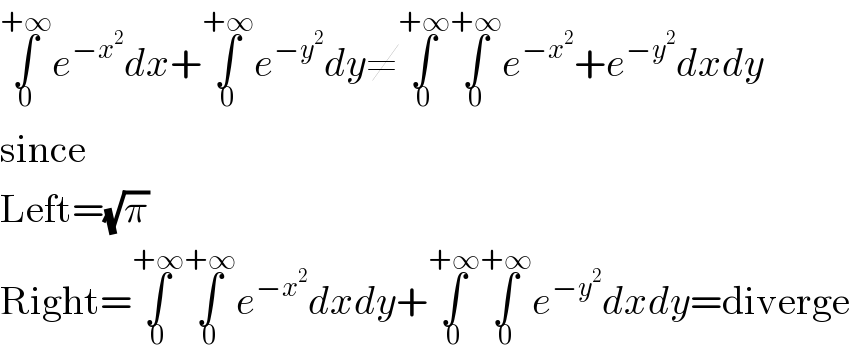
$$\underset{\mathrm{0}} {\overset{+\infty} {\int}}{e}^{−{x}^{\mathrm{2}} } {dx}+\underset{\mathrm{0}} {\overset{+\infty} {\int}}{e}^{−{y}^{\mathrm{2}} } {dy}\neq\underset{\mathrm{0}} {\overset{+\infty} {\int}}\underset{\mathrm{0}} {\overset{+\infty} {\int}}{e}^{−{x}^{\mathrm{2}} } +{e}^{−{y}^{\mathrm{2}} } {dxdy} \\ $$$$\mathrm{since} \\ $$$$\mathrm{Left}=\sqrt{\pi} \\ $$$$\mathrm{Right}=\underset{\mathrm{0}} {\overset{+\infty} {\int}}\underset{\mathrm{0}} {\overset{+\infty} {\int}}{e}^{−{x}^{\mathrm{2}} } {dxdy}+\underset{\mathrm{0}} {\overset{+\infty} {\int}}\underset{\mathrm{0}} {\overset{+\infty} {\int}}{e}^{−{y}^{\mathrm{2}} } {dxdy}=\mathrm{diverge} \\ $$
Answered by 123456 last updated on 22/Nov/15
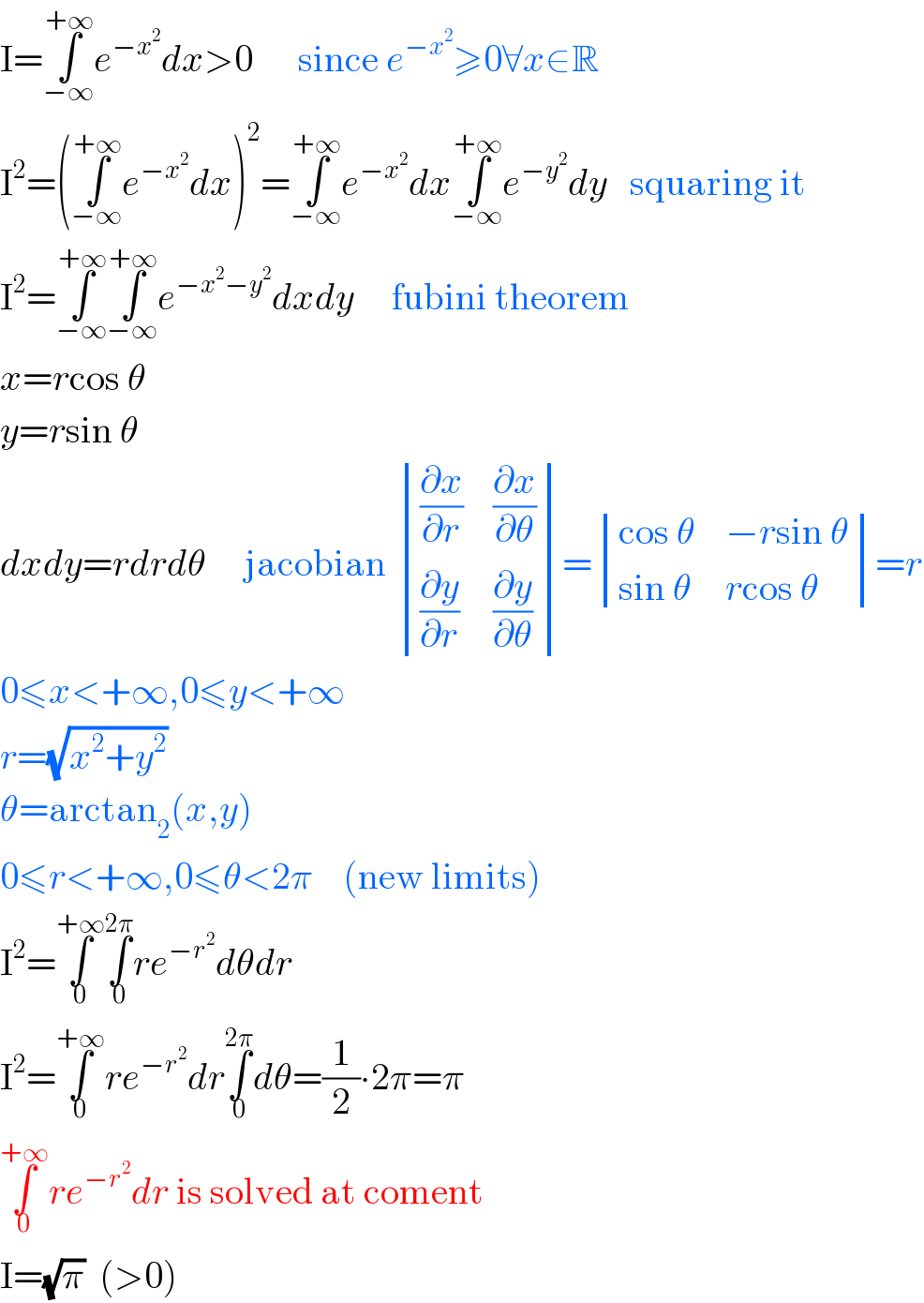
$$\mathrm{I}=\underset{−\infty} {\overset{+\infty} {\int}}{e}^{−{x}^{\mathrm{2}} } {dx}>\mathrm{0}\:\:\:\:\:\:\mathrm{since}\:{e}^{−{x}^{\mathrm{2}} } \geqslant\mathrm{0}\forall{x}\in\mathbb{R} \\ $$$$\mathrm{I}^{\mathrm{2}} =\left(\underset{−\infty} {\overset{+\infty} {\int}}{e}^{−{x}^{\mathrm{2}} } {dx}\right)^{\mathrm{2}} =\underset{−\infty} {\overset{+\infty} {\int}}{e}^{−{x}^{\mathrm{2}} } {dx}\underset{−\infty} {\overset{+\infty} {\int}}{e}^{−{y}^{\mathrm{2}} } {dy}\:\:\:\mathrm{squaring}\:\mathrm{it} \\ $$$$\mathrm{I}^{\mathrm{2}} =\underset{−\infty} {\overset{+\infty} {\int}}\underset{−\infty} {\overset{+\infty} {\int}}{e}^{−{x}^{\mathrm{2}} −{y}^{\mathrm{2}} } {dxdy}\:\:\:\:\:\mathrm{fubini}\:\mathrm{theorem} \\ $$$${x}={r}\mathrm{cos}\:\theta \\ $$$${y}={r}\mathrm{sin}\:\theta \\ $$$${dxdy}={rdrd}\theta\:\:\:\:\:\mathrm{jacobian}\:\begin{vmatrix}{\frac{\partial{x}}{\partial{r}}}&{\frac{\partial{x}}{\partial\theta}}\\{\frac{\partial{y}}{\partial{r}}}&{\frac{\partial{y}}{\partial\theta}}\end{vmatrix}=\begin{vmatrix}{\mathrm{cos}\:\theta}&{−{r}\mathrm{sin}\:\theta}\\{\mathrm{sin}\:\theta}&{{r}\mathrm{cos}\:\theta}\end{vmatrix}={r} \\ $$$$\mathrm{0}\leqslant{x}<+\infty,\mathrm{0}\leqslant{y}<+\infty \\ $$$${r}=\sqrt{{x}^{\mathrm{2}} +{y}^{\mathrm{2}} } \\ $$$$\theta=\mathrm{arctan}_{\mathrm{2}} \left({x},{y}\right) \\ $$$$\mathrm{0}\leqslant{r}<+\infty,\mathrm{0}\leqslant\theta<\mathrm{2}\pi\:\:\:\:\left(\mathrm{new}\:\mathrm{limits}\right) \\ $$$$\mathrm{I}^{\mathrm{2}} =\underset{\mathrm{0}} {\overset{+\infty} {\int}}\underset{\mathrm{0}} {\overset{\mathrm{2}\pi} {\int}}{re}^{−{r}^{\mathrm{2}} } {d}\theta{dr} \\ $$$$\mathrm{I}^{\mathrm{2}} =\underset{\mathrm{0}} {\overset{+\infty} {\int}}{re}^{−{r}^{\mathrm{2}} } {dr}\underset{\mathrm{0}} {\overset{\mathrm{2}\pi} {\int}}{d}\theta=\frac{\mathrm{1}}{\mathrm{2}}\centerdot\mathrm{2}\pi=\pi \\ $$$$\underset{\mathrm{0}} {\overset{+\infty} {\int}}{re}^{−{r}^{\mathrm{2}} } {dr}\:\mathrm{is}\:\mathrm{solved}\:\mathrm{at}\:\mathrm{coment} \\ $$$$\mathrm{I}=\sqrt{\pi}\:\:\left(>\mathrm{0}\right) \\ $$
Commented by Filup last updated on 22/Nov/15

$${Wow}!\:\mathscr{T}{hank}\mathscr{Y}{ou}\:{very}\:{much}! \\ $$
Commented by Filup last updated on 22/Nov/15

$$\mathrm{How}\:\mathrm{did}\:\mathrm{you}\:\mathrm{get}\:{dxdy}={rdrd}\theta? \\ $$
Commented by 123456 last updated on 22/Nov/15

$$\mathrm{jacobian}\:\mathrm{of}\:\mathrm{transformation} \\ $$$$\mathrm{J}\left({r},\theta\right)=\frac{\partial\left({r},\theta\right)}{\partial\left({x},{y}\right)}=\begin{vmatrix}{\frac{\partial{x}}{\partial{r}}}&{\frac{\partial{x}}{\partial\theta}}\\{\frac{\partial{y}}{\partial{r}}}&{\frac{\partial{y}}{\partial\theta}}\end{vmatrix} \\ $$$${dxdy}=\mid\mathrm{J}\left({r},\theta\right)\mid{drd}\theta \\ $$
Commented by Filup last updated on 22/Nov/15

$$\mathrm{I}\:\mathrm{have}\:\mathrm{no}\:\mathrm{idea}\:\mathrm{what}\:\mathrm{that}\:\mathrm{is}.\:\mathrm{It}\:\mathrm{seems} \\ $$$$\mathrm{I}\:\mathrm{have}\:\mathrm{some}\:\mathrm{research}\:\mathrm{to}\:\mathrm{conduct} \\ $$
Commented by 123456 last updated on 22/Nov/15
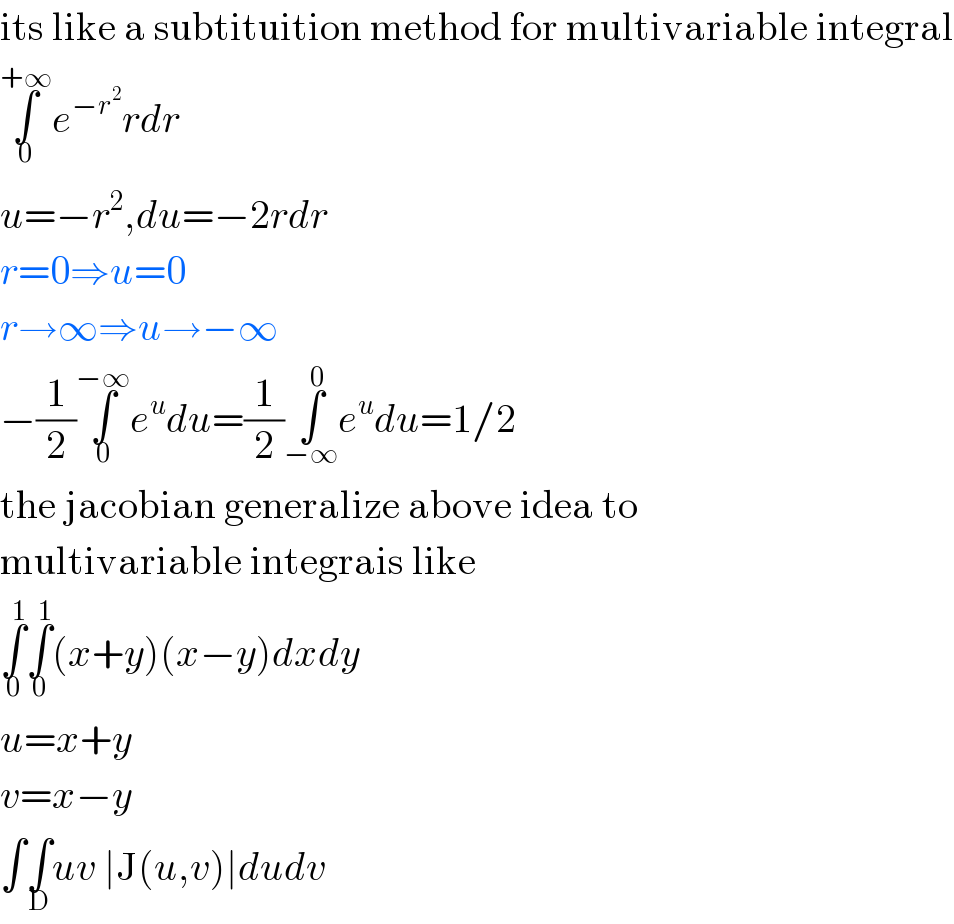
$$\mathrm{its}\:\mathrm{like}\:\mathrm{a}\:\mathrm{subtituition}\:\mathrm{method}\:\mathrm{for}\:\mathrm{multivariable}\:\mathrm{integral} \\ $$$$\underset{\mathrm{0}} {\overset{+\infty} {\int}}{e}^{−{r}^{\mathrm{2}} } {rdr} \\ $$$${u}=−{r}^{\mathrm{2}} ,{du}=−\mathrm{2}{rdr} \\ $$$${r}=\mathrm{0}\Rightarrow{u}=\mathrm{0} \\ $$$${r}\rightarrow\infty\Rightarrow{u}\rightarrow−\infty \\ $$$$−\frac{\mathrm{1}}{\mathrm{2}}\underset{\mathrm{0}} {\overset{−\infty} {\int}}{e}^{{u}} {du}=\frac{\mathrm{1}}{\mathrm{2}}\underset{−\infty} {\overset{\mathrm{0}} {\int}}{e}^{{u}} {du}=\mathrm{1}/\mathrm{2} \\ $$$$\mathrm{the}\:\mathrm{jacobian}\:\mathrm{generalize}\:\mathrm{above}\:\mathrm{idea}\:\mathrm{to} \\ $$$$\mathrm{multivariable}\:\mathrm{integrais}\:\mathrm{like} \\ $$$$\underset{\mathrm{0}} {\overset{\mathrm{1}} {\int}}\underset{\mathrm{0}} {\overset{\mathrm{1}} {\int}}\left({x}+{y}\right)\left({x}−{y}\right){dxdy} \\ $$$${u}={x}+{y} \\ $$$${v}={x}−{y} \\ $$$$\int\underset{\mathrm{D}} {\int}{uv}\:\mid\mathrm{J}\left({u},{v}\right)\mid{dudv} \\ $$
Commented by Filup last updated on 22/Nov/15
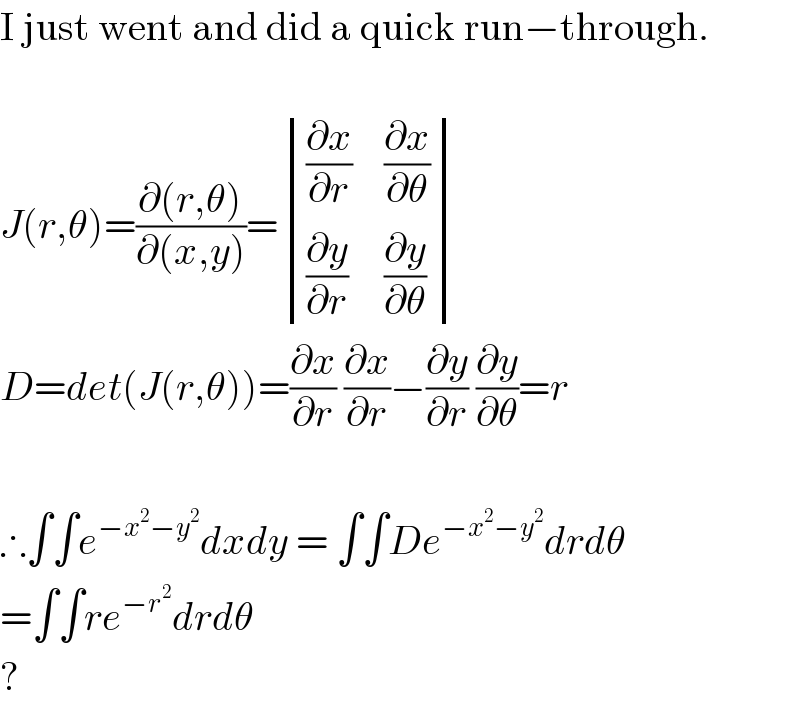
$$\mathrm{I}\:\mathrm{just}\:\mathrm{went}\:\mathrm{and}\:\mathrm{did}\:\mathrm{a}\:\mathrm{quick}\:\mathrm{run}−\mathrm{through}. \\ $$$$ \\ $$$${J}\left({r},\theta\right)=\frac{\partial\left({r},\theta\right)}{\partial\left({x},{y}\right)}=\begin{vmatrix}{\frac{\partial{x}}{\partial{r}}}&{\frac{\partial{x}}{\partial\theta}}\\{\frac{\partial{y}}{\partial{r}}}&{\frac{\partial{y}}{\partial\theta}}\end{vmatrix} \\ $$$${D}={det}\left({J}\left({r},\theta\right)\right)=\frac{\partial{x}}{\partial{r}}\:\frac{\partial{x}}{\partial{r}}−\frac{\partial{y}}{\partial{r}}\:\frac{\partial{y}}{\partial\theta}={r} \\ $$$$ \\ $$$$\therefore\int\int{e}^{−{x}^{\mathrm{2}} −{y}^{\mathrm{2}} } {dxdy}\:=\:\int\int{De}^{−{x}^{\mathrm{2}} −{y}^{\mathrm{2}} } {drd}\theta \\ $$$$=\int\int{re}^{−{r}^{\mathrm{2}} } {drd}\theta \\ $$$$? \\ $$
Commented by Filup last updated on 22/Nov/15

$$\mathrm{How}\:\mathrm{do}\:\mathrm{you}\:\mathrm{determine}\:\mathrm{the}\:\mathrm{new}\:\mathrm{limits}? \\ $$
Commented by 123456 last updated on 22/Nov/15

$$−{r}^{\mathrm{2}} \\ $$$$−{x}^{\mathrm{2}} −{y}^{\mathrm{2}} =−{r}^{\mathrm{2}} \left(\mathrm{cos}^{\mathrm{2}} \theta+\mathrm{sin}^{\mathrm{2}} \theta\right)=−{r}^{\mathrm{2}} \\ $$
Commented by 123456 last updated on 22/Nov/15
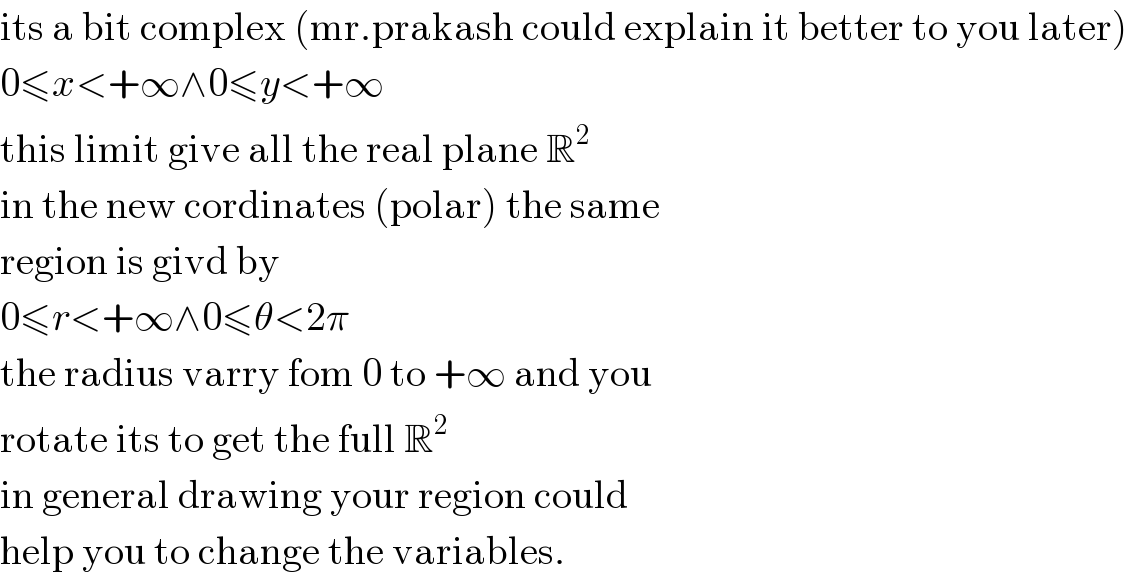
$$\mathrm{its}\:\mathrm{a}\:\mathrm{bit}\:\mathrm{complex}\:\left(\mathrm{mr}.\mathrm{prakash}\:\mathrm{could}\:\mathrm{explain}\:\mathrm{it}\:\mathrm{better}\:\mathrm{to}\:\mathrm{you}\:\mathrm{later}\right) \\ $$$$\mathrm{0}\leqslant{x}<+\infty\wedge\mathrm{0}\leqslant{y}<+\infty \\ $$$$\mathrm{this}\:\mathrm{limit}\:\mathrm{give}\:\mathrm{all}\:\mathrm{the}\:\mathrm{real}\:\mathrm{plane}\:\mathbb{R}^{\mathrm{2}} \\ $$$$\mathrm{in}\:\mathrm{the}\:\mathrm{new}\:\mathrm{cordinates}\:\left(\mathrm{polar}\right)\:\mathrm{the}\:\mathrm{same} \\ $$$$\mathrm{region}\:\mathrm{is}\:\mathrm{givd}\:\mathrm{by} \\ $$$$\mathrm{0}\leqslant{r}<+\infty\wedge\mathrm{0}\leqslant\theta<\mathrm{2}\pi \\ $$$$\mathrm{the}\:\mathrm{radius}\:\mathrm{varry}\:\mathrm{fom}\:\mathrm{0}\:\mathrm{to}\:+\infty\:\mathrm{and}\:\mathrm{you} \\ $$$$\mathrm{rotate}\:\mathrm{its}\:\mathrm{to}\:\mathrm{get}\:\mathrm{the}\:\mathrm{full}\:\mathbb{R}^{\mathrm{2}} \\ $$$$\mathrm{in}\:\mathrm{general}\:\mathrm{drawing}\:\mathrm{your}\:\mathrm{region}\:\mathrm{could} \\ $$$$\mathrm{help}\:\mathrm{you}\:\mathrm{to}\:\mathrm{change}\:\mathrm{the}\:\mathrm{variables}. \\ $$
Commented by Filup last updated on 22/Nov/15

$${Whoops}!\:\mathrm{Thanks}\:\mathrm{for}\:\mathrm{pointing}\:\mathrm{out}\:\mathrm{that} \\ $$$$\mathrm{typo}.\:\mathrm{Ok},\:\mathrm{I}\:\mathrm{understand}\:\mathrm{now}!\: \\ $$$$ \\ $$$$\mathrm{I}\:\mathrm{have}\:\mathrm{done}\:\mathrm{minimal}\:\mathrm{work}\:\mathrm{on}\:\mathrm{matricies} \\ $$$$\mathrm{but}\:\mathrm{I}\:\mathrm{worked}\:\mathrm{it}\:\mathrm{all}\:\mathrm{out}\:\mathrm{just}\:\mathrm{now}! \\ $$$$\mathrm{Thank}\:\mathrm{you}\:\mathrm{for}\:\mathrm{helping}\:\mathrm{me}! \\ $$$$ \\ $$$${The}\:\mathrm{limits}\:\mathrm{are}\:\mathrm{probably}\:\mathrm{the}\:\mathrm{most}\:\mathrm{confusing} \\ $$$$\mathrm{right}\:\mathrm{now}.\:\mathrm{I}'\mathrm{ll}\:\mathrm{look}\:\mathrm{into}\:\mathrm{it}! \\ $$$$ \\ $$
Commented by Filup last updated on 22/Nov/15
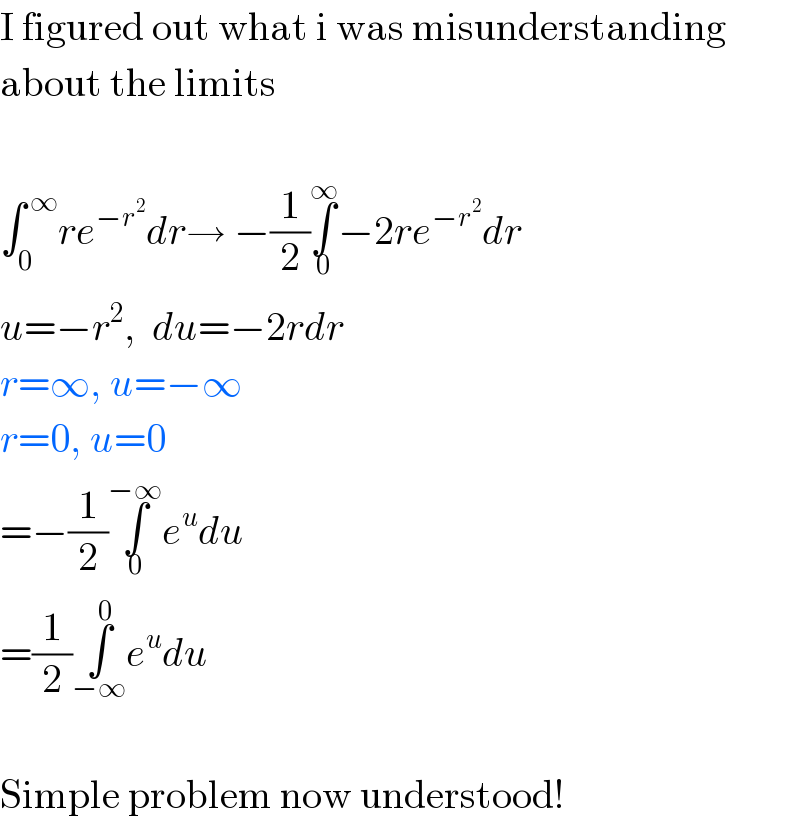
$$\mathrm{I}\:\mathrm{figured}\:\mathrm{out}\:\mathrm{what}\:\mathrm{i}\:\mathrm{was}\:\mathrm{misunderstanding} \\ $$$$\mathrm{about}\:\mathrm{the}\:\mathrm{limits} \\ $$$$ \\ $$$$\int_{\mathrm{0}} ^{\:\infty} {re}^{−{r}^{\mathrm{2}} } {dr}\rightarrow\:−\frac{\mathrm{1}}{\mathrm{2}}\underset{\mathrm{0}} {\overset{\infty} {\int}}−\mathrm{2}{re}^{−{r}^{\mathrm{2}} } {dr} \\ $$$${u}=−{r}^{\mathrm{2}} ,\:\:{du}=−\mathrm{2}{rdr} \\ $$$${r}=\infty,\:{u}=−\infty \\ $$$${r}=\mathrm{0},\:{u}=\mathrm{0} \\ $$$$=−\frac{\mathrm{1}}{\mathrm{2}}\underset{\mathrm{0}} {\overset{−\infty} {\int}}{e}^{{u}} {du} \\ $$$$=\frac{\mathrm{1}}{\mathrm{2}}\underset{−\infty} {\overset{\mathrm{0}} {\int}}{e}^{{u}} {du} \\ $$$$ \\ $$$$\mathrm{Simple}\:\mathrm{problem}\:\mathrm{now}\:\mathrm{understood}! \\ $$
